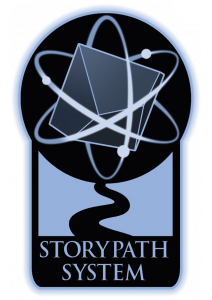
We’ve been getting a lot of questions about Scale: what it is, when it applies, and how we adjudicate it. Hopefully this post will clarify that for those of you wondering how to use Scale in your game.
Scale is a narrative term that is used as a shorthand to describe large differences between two things. We often use Scale as a comparison between two things, such as the speed of a human on foot versus that of a person on a bike, and further, to that of a car or plane. Scale is a comparison mechanic to help us decide if something or someone is so outclassing someone else that a normal roll with standard successes just doesn’t express that difference well enough.
For example, we don’t talk about Danielle’s Scale for running around unless it comes into contrast with something else. If Danielle got into a foot race with Eddy, there is no Scale difference between us. Even if Eddy spent his time off training for marathons, his comparative Scale is not that much higher than Danielle’s, though his Athletics and Stamina are probably much higher, so his roll in the foot race is likely to be better than Danielle’s. If Danielle had to outrun a car, she’s unlikely to be able to do so, as the car (unless something was seriously wrong with it) is inherently able to go faster than any human can at sustained speeds.
Scale is also not a universal constant. If a car has a Scale against Danielle in a race, it certainly doesn’t have Scale against her in a game of chess. In fact, Danielle’s Scale in that instance is so much laughably higher than the car’s that it isn’t even worth rolling or talking about. The car just can’t play chess. And in the same vein, the Scale of the car’s durability versus Danielle if she tried to punch the thing to stop it is so high that she wouldn’t even get a roll to try.
Now, if we do need to make a roll in an attempt to see if Danielle’s sword can cut through the hood of the car to stop it — ha, no bare-fisted car assault for me! — we’re going to still apply the difference between the car’s durability Scale and the sword’s power Scale to the action as Enhancement at a rate of 2 Enhancement to 1 difference in Scale. We’ll likely apply it as the car’s Defense since that’s how many successes she needs to hurt the car.
So, if something has Scale in one arena, it doesn’t necessarily have Scale in another. Scion does a good job of pointing out which areas might have Scale, but even it isn’t completely comprehensive. I suspect Aberrant to have the most comprehensive list available. Here’s some things to which Scale might apply: size, speed, power/force, durability/armor, leadership, socializing, mental calculations. This isn’t a comprehensive list, but it gives you an idea of how and when Scale might come into play.
Dramatic vs. Narrative Scale
Another thing we should talk about is the difference between dramatic and narrative Scale. The examples above mostly use Dramatic Scale, which is useful when a roll result matters such as in a contest between two actors. But sometimes Scale comes up in situations where opposition isn’t dramatic, so the action is more narrative. Think of this as chewing up the scenery. The difference between when something is narrative and when it is dramatic is a bit subjective, just like figuring out when a character needs to roll to accomplish an action vs. being able to just do it because they are super cool.
Narrative Scale comes into play when a fine-grain application of successes doesn’t matter and the action that would use that system isn’t dramatic. Examples include a speedster getting to the other side of the city, a cyborg solving a complicated quantum equation, or a superpowered human bringing down a building. What we want to know is how many successes can we pile on it, i.e. “how well did we win against it?” The giant fighting robot with a huge power Scale can probably punch through buildings. And its power Scale compared to a building’s durability Scale is probably a bit higher, but we want to pile on enough successes to knock the thing down, but that durability is likely to result in a high difficulty, just because, well, it’s a skyscraper. So we don’t just roll and add a few Enhancement, we roll and multiply successes by the difference in Scale. We could also not roll at all and get some successes based on the dice pool and multiplying.
When to Apply Scale
Okay, so that’s how Scale works in the big picture, but how do we figure out when to apply Scale to a situation? Well, this is going to be a bit of a judgment call by the Storyguide, and sometimes specific powers will tell us when to apply Scale to the situation. For instance, if something makes sense to just be bigger, stronger, faster, more durable, or have more computational power in a way that is dramatically different, you’ll want to apply Scale to that aspect vs. the characters. Determining how much Scale difference is somewhat subjective, but that’s why we’ve included some examples in the book to try to give you a perspective on what real-world things have Scale in certain areas. So, when you make a 15-story tall monster for the characters to fight, you might want to throw some size Scale on it, which might also give it some durability Scale.
But that prompts the question: When do characters get Scale? And the answer is: when a piece of equipment or the character’s powers say they do. Scions have a ton of Knacks that manipulate Scale for various things, giving them Scale for certain types of action, or reducing the Scale of something else for their action. Essentially, closing the distance between themselves and the god-like monsters against whom they fight.
Characters in the Trinity Continuum get Scale through powers and sometimes equipment. Talents have Gifts, psions have Psi powers, and novas have Quantum Traits that all give them some access to Scale, which applies in certain arenas and on specific rolls, but not all rolls. Talents can spend Inspiration to increase their Scale for a single action, hopefully reducing the difference between themselves and something bigger than them, or making them so much better than the average human that it shows as Scale. Novas will have some ways to get inherent Scale bonuses to certain actions as described in the power.
The underlying thing to remember is that Scale is both subjective (given by the Storyguide in places where it makes sense, because an item or creature deserves to narratively have Scale) and objective (given by the game book by a power or in a piece of equipment’s description). This means that sometimes your character will mostly get Scale through her powers or equipment via what the game book says and sometimes when the Storyguide says, and non-player characters will always get Scale because of both when the Storyguide decides it and because the book suggested it.
Is Tier Scale?
Short answer, no. There has been some question about how Tier effects Scale, and the longer answer is: It doesn’t, really. The Trinity Continuum had a chart in it which was left over from an earlier version that confused the issue, but all Tier does is describe a very out-of-game system, which is what the player’s target number on the die is for a success, with a base of 8 and moving down depending on Tier. Higher-Tier characters may have more access to abilities that give them Scale for certain actions, but they are not like race cars compared to humans just because they have a higher Tier.
Scion vs. Trinity Continuum
Scale is used and described somewhat differently in Scion than it is in the Trinity Continuum. Baseline humans in Scion are Scale 0, and each level of Scale is the narrative difference between baseline human and things that are just better than that. In the Trinity Continuum, the baseline human is set at Scale 1, because some things have a Scale of 0 elsewhere and we wanted to be able to reserve that for special cases. The difference in Scale between normal humans and other stuff in each of the various categories is still the same between Scion and the Trinity Continuum, so don’t let the baseline confuse you.

Comments
4 responses to “Storypath’s Scale”
Nice text, helped a lot to explain to those that didn’t get. I honestly had a long issue to get it, luckily somo devs helped.
Thanks!
Nice article. A few actual examples would make it go alot farther, especially when alot of the article seems to be “Scion does it this way, but Trinity, while similar, does it that way.”
Just my 2 drachma.
I think the big difference between Scion and Trinity is the fact that TC is far less flexible on the use of many things. That’s not a bad thing, Trinity deals with things on a more hard way, the car is size 2, the bike is size 0, the PK can fly up to speed 3, things like that, while Scion is more like you can act on scale 2 while dealing with things related your divine title.
The Myths are loosely described, and it’s the way Scion deal with it, while TC is SciFi so we expect a clear list of things you can do as it is more “scientific”…
Sounds like you are getting down some of the streamlining between the various types as well.